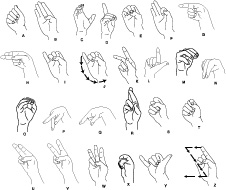Deaf and hard of hearing students at Palo Alto College give new meaning to the term word-of-mouth. The Deaf and hard of hearing population at Palo Alto has grown by nearly 40 percent every semester for the past five semesters. The reason is, satisfied students who spread praise by traditional word-of-mouth, or more appropriately, sign-of-hand. |
 |
Along the walkways of Palo Alto, bilingual and even trilingual students talk and laugh, sharing and listening to sagas. This is a natural sight on the campus of a college. Among the speaking and hearing students is the Deaf or hard of hearing and American Sign Language speaking students like Elizabeth Bullard, who is an undeclared freshman. Ninety percent of families of Deaf or hard of hearing students, including Bullard’s, are not fluent in sign, so, campus life is social life for many. There are students who consider themselves members of the “Capital D” Deaf community. They hear nothing and depend on Sign Language and interpretation to communicate. Some students have partial hearing and depend on Speech Reading (lip reading) and residual hearing to communicate. These are people who, like Bullard, read gestures, facial expressions and lip movement, and who can hear slight tone or pitch. They may consider themselves hard of hearing or hearing impaired, and not part of the “Capital D” deaf community. Either term, “Deaf” or “deaf”, identifies the students’ individualism. When asked what concerned her about deaf students at Palo Alto, Bullard expressed a deep concern for the need of understanding and patience when it comes to interaction between hearing and non-hearing people. She also said receiving thorough and accurate notes, and interpreters who really understand ASL is also important. English and ASL are different, and the learning community doesn't always know this. The services provided to Deaf and hard of hearing students at Palo Alto include note takers, language and oral interpreters and special testing accommodations. Thirteen Deaf or hard of hearing students attend PAC full-time and part-time. Palo Alto’s Lead Interpreter, Renae Quick, said that the most important thing to remember regarding Deaf or hard of hearing students is that they can do anything that hearing people can do except hear. Quick and Peggy Taylor, the other full-time Sign Language interpreter, dedicate 100 hours weekly toward interpreting for the Deaf and hard of hearing. All of the campus interpreters are in class all the time, sometimes consecutively with little time to rest their hands and ears. Bullard said, “We need more [interpreters] so they’ll be fresh and not tired.” Quick, who also teaches an American Sign Language course at Palo Alto, said that getting enough staff to meet the requests for special services is difficult. Bullard suggests that students share their notes and study together in order for Deaf or hard of hearing students to learn adequately and mingle with their peers. Volunteers for note taking, reading and writing are always needed. Students are encouraged to volunteer their services in the Palomino Center, Room 119. Eight students belong to the work-study program to aid the Deaf or hard of hearing students, but with 13 Deaf or hard of hearing students on campus, Quick and Bullard think there should be at least 13 paid and unpaid staff to aid them. Quick said that the oppression that deaf people face is different from that of people with speaking barriers. She said that people need patience, and they have to realize that it could only be a matter of time when a life-altering incident could disable their senses. For special events or functions, a Deaf or hard of hearing student has to request an interpreter four days in advance and basically hope that they are able to go. This is a small example of the every day struggle a Deaf or hard of hearing student may face. The student body can help by being open-minded and tolerant to differences. For many hearing students, knowing how to approach a Deaf or hard of hearing student is difficult. The deaf community wants the hearing to know that eye contact and patience are keys to communication. Most deaf people do not consider themselves as disabled, and they want to belong to the general population without a label. Nancy Cantu, a second year Social Work major said, “I know other people think I have a disability, but I don’t think I do…I can do many things…I just can’t hear.” For more information on the deaf student community, contact Renae Quick. |
|